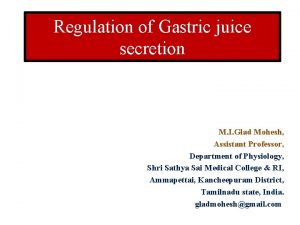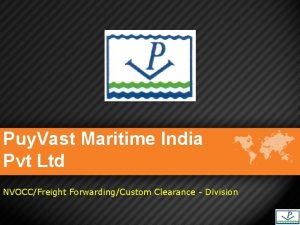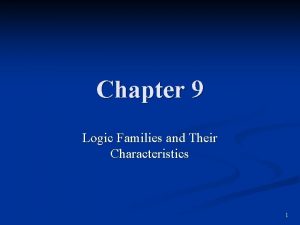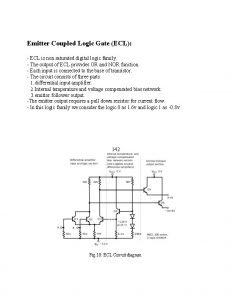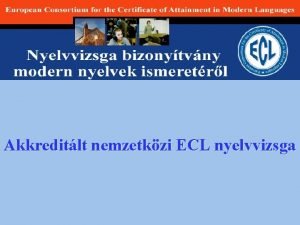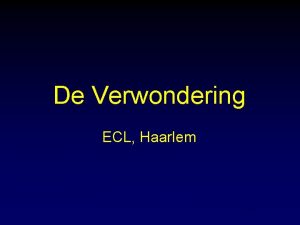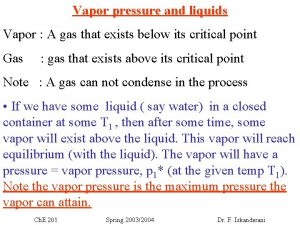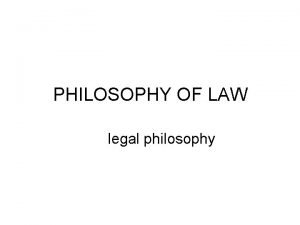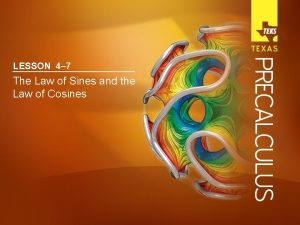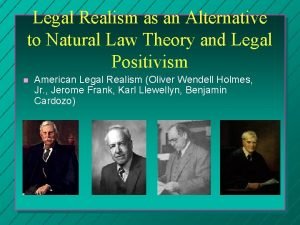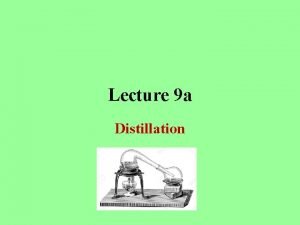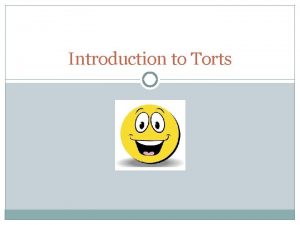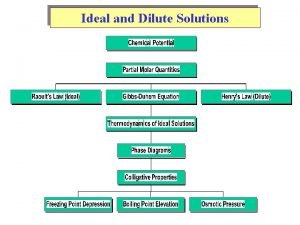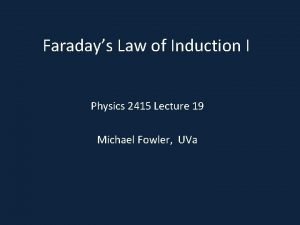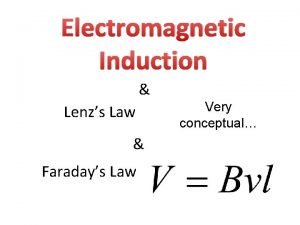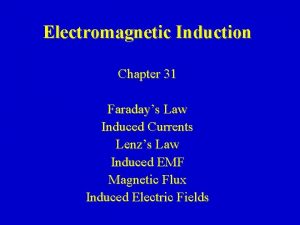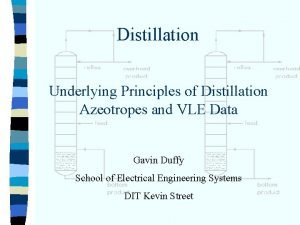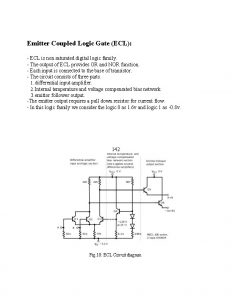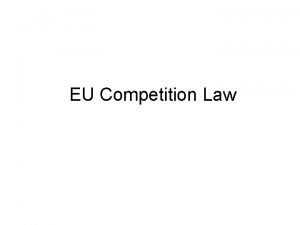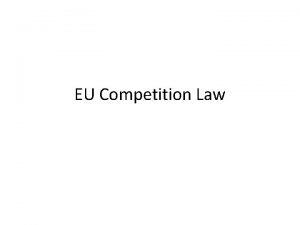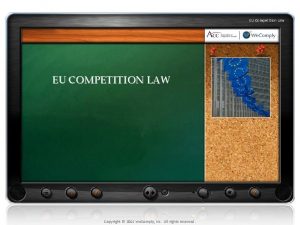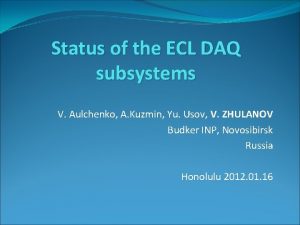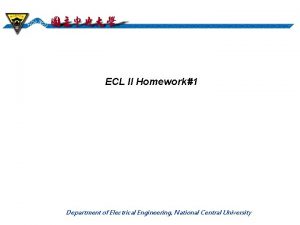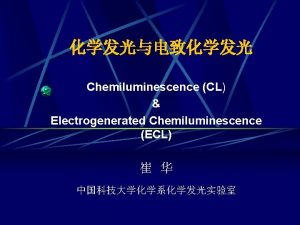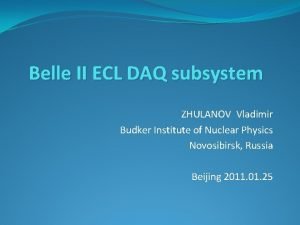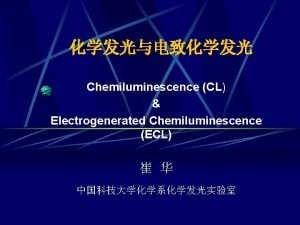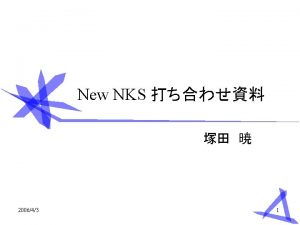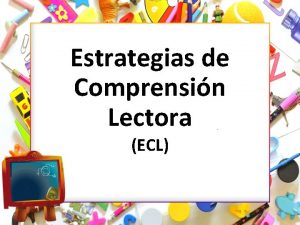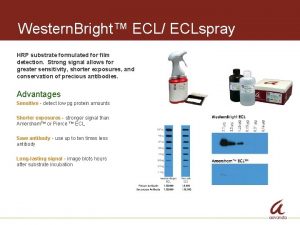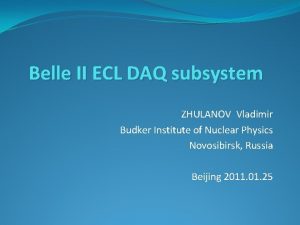2 EU Competition law ECL COMPETITION law in


































- Slides: 34

2. EU Competition law (ECL) COMPETITION law (in Europe) = ANTITRUST law (USA) ‘rules that are intended to protect the process of competition in order to maximise consumer welfare’ (R. Whish, Competition law, 6 th edition, OUP page 1) European Competition Law (ECL) alongside 28 Member States’ competition law regimes

Main ECL sources EU primary rules: § Article 101 & Article 102 TFEU TEEC of 1957 → renamed TEC in Maastricht in 1992 → renamed TFEU in Lisbon in 2007 Þ Þ Art. 85 TEEC 1992→ 81 TEC→ 101 TFEU 2007 Art. 86 TEEC 1992→ 82 TEC→ 102 TEFU 2007 + Key EU secondary legislation: § 2004 Merger Regulation Council Reg 139/2004 of 20/01/04 on the control of concentrations between undertakings = (replaced the 1 st MR of 1989) Council Regulation 1/2003 of 16 th December 2002 on the implementation of the rules on competition laid down in Articles 81 and 82 of the Treaty § Commission Regulation 802/2004 of 7 th April 2004 implementing Council Regulation 139/2004 amended by Commission Regulation 1033/2008 of 20 th October 2008 §

WHAT is competition law? 2. 1. WHO does ECL apply to ? 2. 2. WHY is ECL used? 2. 3. WHAT practices are covered by ECL? 2. 4. WHAT is the JURISDICTIONAL SCOPE of ECL? 2. 4. 1. WHEN is ECL applicable ? 2. 4. 2. WHO can ‘enforce’ ECL ? 2. 5. HOW is ECL enforced ? 2. 6. WHAT enforcement INSTRUMENTS are used? 2. 7. WHAT is the FRAME OF REFERENCE of an ECL assessment?

2. 1. ‘Subjects’ of ECL Who does ECL apply to/who has to comply with competition law? Competition law is addressed to (directed at/applies to/must be complied with by) those that engage in an economic activity UNDERTAKINGS and their associations �entities organising / rendering public utilities (providers of SGEI) � primarily �free professionals � natural persons controlling at least one undertaking

Undertakings Competition law applies to all undertakings (understood in a very wide, functional sense of the word) Ø engaged in any type of economic activity even if its primary function is not commercial eg Olympic Committee, Biblioteka Narodowa Ø participating in a market place Ø individual or collective eg BBC & European Broadcasting Union (TP SA is a member) Ø whereby their profitability & form are irrelevant Ø private and public - in Poland very often ‘gmina’ Ø of any ‘national origin’ - company registered in the country of investigation as well as elsewhere in the world

ECL & economy ECL applies to ‘those engaged in an economic activity’ = BUSINESS LAW As a rule, ECL APPLIES TO THE ENTIRE EU ECONOMY = no industry sector in ‘immune’ to competition ECL! but. . . Art. 14 TFEU ‘. . . given the place occupied by [SGEI] in the shared values of the [EU] as well as their role in promoting social and territorial cohesion, [the EU and MSs]. . . shall take care that such services operate on the basis of principles and conditions. . . which enable them to fulfil their missions. Applicability of ECL can be excluded on the basis of the derogation in Art. 106 TFEU for services of general economic interest (SGEI)

2. 2. Goals of ECL Why is ECL used? Ø ultimate purpose of ECL : maximising consumer welfare (but what is in the interest of consumers in the digital economy? ) Ø direct aims of ECL: � (PRESENT) protect existing competition � (PAST) counteract practices that have eliminated or distorted competition in the past � (FUTURE ) prevent anticompetitive practices from happening � EU market integration (creation of the Internal Market) � Others eg: maximising progress, facilitating economic freedom by eliminating competition distortions, The goals (aims, purpose) of competition law are not clear cut and can differ between countries/regions!

Competition = essence of economic freedom (free/fair rivalry of independent firms) + basis of effectiveness and welfare FREE COMPETITION no unnecessary state intervention (Smith) + no interference from other market players (Hoppmann) ≠ EFFECTIVE COMPETITION from 1940’ workable competition (Clark) ’a degree of competition necessary to ensure the observance of the basic requirements and attainment of the objectives of the Treaty’ COMPETITORS (act at the same level of the production & distribution chain) = HORIZONTAL RELATIONSHIP

2. 3. ‘Material scope’ of ECL What practices are covered/‘caught’ by ECL? ECL goes against anticompetitive economic activities ‘RESTRICTIVE’ PRACTICES = practices restricting competition: 1) ANTICOMPETITIVE multilateral PRACTICES (committed by at least 2 parties) : anticompetitive agreements, decisions of associations of undertakings and concerted practices (cartels) 2) ANTICOMPETITIVE unilateral PRACTICES (committed by 1 entity) : exclusionary and exploitive abuse of dominant position ANTICOMPETITIVE CONCENTRATIONS: 3) CONCENTRATIONS (mergers and acquisitions incl. ‘full function’ joint ventures ) that might have a SIGNIFICANT (NEGATIVE) EFFECT ON EFFECTIVE COMPETITION in the Internal Market

Prohibitions? Art. 101 TFEU prohibits 1) Anticompetitive AGREEMENTS and DECISIONS by associations of undertakings as well as CONCERTED PRACTICES (cartels) Art. 102 TFEU prohibits 2) dominant position ABUSE 2004 Merger Regulation prevents 3) implementation of ANTICOMPETITIVE CONCENTRATIONS

2. 4. EU ‘jurisdiction’ What is the jurisdictional scope of ECL? NOTE: Definition of ‘JURISDICTION’ (OUP) I. the territory or sphere of activity over which the legal authority of a court or other institution extends Eg: ‘Polish police has the jurisdiction to investigate murders committed in Poland’ ‘competition law is based on extra-territorial jurisdiction and as a result, it applies irrespective of the place of establishment of a company or the location of the practice’ II. the official power to make legal decisions and judgements: eg: ‘the Commission has sole jurisdiction to rule on mergers with EU dimension’ ‘the Commission does not have jurisdiction to deal with murder’ III. a system of law courts (a judicature) eg ‘most EU jurisdictions (MSs) have very similar competition rules’ ‘ one has to consider many issues when choosing the most suitable jurisdiction for establishing a given type of company’

Jurisdictional criteria JURISDICTIONAL CRITERIA => determine the applicability of a given legal system = factors deciding (1) ‘whose’ law is applicable to a given situation/market practice/entity & (2) ‘who’ can enforce that law TYPICAL Jurisdictional criteria: ‘nationality’ of the company involved/ victim/perpetrator or the ‘location of the conduct in question JURISDICTIONAL CRITERIA for competition law are not bound by the ‘origin’ of parties nor the ‘location of conduct’ INSTEAD => the applicability of given competition law regimes is usually decided with reference to Ø a given practice’s EFFECT (even only potential) on a specific economy or it can relate to Ø the size of the company/companies concerned

Extra-territoriality Ø Since they look at effects/size when deciding if they are applicable rather competition laws have EXTRATERRITORIAL jurisdiction = the applicability of than territory, rules of a given region outside its borders Ø Since the applicability of one legal regimes does not have to exclude the applicability of another, it is not uncommon for a company to be obliged to comply with multiple sets of competition rules (eg EU + MSs + US + Japan) with respect to a single market practice whether it is an infringement or a merger NOTE: Hence, it is also not uncommon for large companies to be investigated simultaneously by multiple (from different countries/regions) public authorities/courts

2. 4. 1. Jurisdiction: applicability When is ECL applicable? JURISDICTIONAL CRITERIA of ECL: a) ‘effect on EU trade’ for restrictive practices b) EU (Community) dimension for concentrations In other words, ECL is applicable to: Ø restrictive practices (based on Art. 101 & 102 TFEU) with ‘effect on EU trade’ -> when a restrictive multilateral or unilateral practice has/can have an effect on EU trade Ø concentrations (based on the MR) with EU (Community) dimension -> all M&As (irrespective of the origins of their parties) provided their parties are large enough

Effect on EU trade exists/can exist: Ø for all EU cross-border practices or Øpractices with effects extending over the territory of an entire national MS market (partitioning); sometimes smaller markets if they are key to the IM ü ANY FORM of INFLUENCE: ‘May have an influence, direct or indirect, actual or potential, on the pattern of trade’ ü ONLY NEGATIVE INFLEUNCE: ’Influence must constitute a threat to EU trade ‘which may harm the attainment of the objectives’ of IM ü ONLY ‘APPRECIABLE’ effect on EU trade since in light of the subsydiarity principle, ECL should only apply to practices that are truly of EU importance

Appreciability of effect Multilateral practices (covered by Art. 101 TFEU) are not normally able to have an appreciable effect if they are small in economic terms: Ø a combined market share on any affected RM in the EU < 5% and; Ø for horizontal agreements, the aggregate annual EU turnover of the participants in the ‘object’ of the agreement upto EUR 40 million 2004 Commission Guidelines on the effect on trade concept contained in Articles 81 and 82 of the Treaty 1997 Notice on agreements of minor importance which do not appreciably restrict competition under Article 81(1) (de minimis): Ø Unilateral practices (Art. 102 TFEU) are assumed to have an appreciable effect if dominance is held Ø on the Internal Market or Ø its substantial part (dominance held on a Relevant Market of EU importance; substantial = economic importance (not necessarily size) eg: an entire single MS or key air/sea ports

EU (Community) Dimension In light of the subsydiarity principle, ECL should only apply to practices that are truly of EU importance leaving smaller practices to be subjected to national competition rules of its MSs => ECL (the MR) is applicable only if the concentration has an EU (Community) dimension determined by specific turnover thresholds for its parties TERMINOLOGY CONFUSION: the Lisbon Treaty changed the term Community into EU – despite the fact that the MR still speaks of ‘Community’ dimension’ – it is now appropriate to call it EU dimension EU (Community) DIMENSION Ø combined EU-wide turnover of each of at least 2 participants > 250 mil EURO unless each of the companies gets more than 2/3/ of its aggregate EU turnover within 1 MS + Ø a combined global turnover > 5 000 mil EURO

ECL vs. MSs competition laws In light of: Ø the direct applicability of EU law (including ECL), and Ø the general extra-territorial character of competition law regimes, which means that the same practice might have to comply with multiple competition laws How does the applicability of ECL affect the applicability of national competition rules of its MSs? Articles 101/102 TFEU (on restrictive practices) apply in parallel to equivalent national rules – due to the supremacy of EU law rule, but they take precedent over national rules in case of a conflict => fulfilling the jurisdictional criteria of ECL does not preclude the applicability of MSs’ competition laws if their jurisdictional criteria are also met) By contrast, when a concentration has EU dimension (the jurisdictional criteria of the EU MR are met), than the applicability of MSs’ national merger rules is excluded

2. 4. 2. Jurisdiction: enforcement WHO can enforce their competition rules? Ø Since it is not uncommon for a company to be obliged to comply with multiple sets of competition rules (eg EU + MSs; EU + MSs + US + Japan) with respect to a single market practice Ø and it is also common for companies to be suspected of breaking multiple sets of rules Ø It is possible that more than one public authority (or private party) will try to enforce its competition rules towards the same practices EU or MSs jurisdiction has no bearing on the jurisdiction of foreign bodies – not only can they apply their NOTE: own rules (general extraterritorial application of competition law), but the authorities can also arrive at different conclusions or use different solutions to resolve the same problem

Public enforcement of Art. 101/102 TFEU Article 101 & 102 TFEU are enforced in parallel by: ü the European Commission and on appeal => CJEU ü National Competition Authorities (NCAs) and on appeal => their national courts This system is known as parallel EU/MSs enforcement of Art. 101& 102 TFEU or results from non-exclusive Commission jurisdiction over the enforcement of Art. 101/102 TFEU In practice, NCAs decide now far more Art. 101 & 102 TFEU cases than the Commission which only deals with cases that are particularly dangerous for the IM, cover large parts of the IM, those that concern novel legal or economic issues or where NCAs failed to achieve the needed result NOTE: ART. 101/102 TFEU, but not the MR, CAN ALSO BE subject to PRIVATE ENFORCEMENT before THE COURTS OF MEMBER STATES but in practice this happens only in the UK, Germany and Holland

Public enforcement of the MR Ø Unlike the enforcement of Articles 101&102 TFEU, merger control (enforcement of merger rules) is not associated with an infringement of ECL. Ø Instead it is a public intervention into the basic freedom of economic activity and thus the rights of the parties have to be protected to the maximum extent possible. Ø In order to minimise the disruption caused by the existence of preemptive control exercised in the EU over all large concentrations, only the Commission has the authority to enforce the MR This system is known as exclusive Commission jurisdiction over the enforcement of the MR or the one-stop-shop principle (if the MR’s jurisdictional criteria [EU dimension] are met, the operation needs to be notified to the Commission only without having to deal with potentially multiple NCAs also)

2. 5. Public vs. private enforcement How is ECL enforced? 1. PUBLIC enforcement of Art. 101/102 TFEU & the MR 2. PRIVATE enforcement of Art. 101/102 TFEU Unlike in the USA, in Europe, PUBLIC enforcement of competition law (ECL & MSs’) is overwhelmingly predominant

Public enforcement ECL In the EU: Øadministrative procedure before the Commission + Øjuridical control by CJEU: General Court 1 st instance (ex CFI) & Court of Justice 2 nd instance (ex ECJ) In MSs (based on MSs’ procedural autonomy): Ø enforcement (in various forms) by National Competition Authorities (NCAs) follows specific national procedures+ Ø judicial control by national courts based on national procedural rules

Private enforcement FULL DIRECT EFFECT civil claims on the basis of Article 101 & 102 infringements! Private enforcement of competition law in national civil courts with respect to restrictive practices (not merger control rules) Civil law claims against those that violated competition law ü ü Compensation claim for loss resulting from a violation Claim to establish that an infringement took place Claim to cease the practice Claim to eliminate the effects of an infringement Directive 2014/104/EU on antitrust damages actions - the so-called ANTITRUST DAMAGES DIRECTIVE was signed into law on 26 November 2014 MS have until 27 December 2016 to implement it

2. 6. Pub. enforcement decisions What enforcement instruments are used? Restrictive practices (101/102 TFEU) Art. 7 Reg 1/2003 – infringement decision Art. 8 Reg 1/2003 – interim measures Art. 9 Reg 1/2003 – commitments decisions Art. 10 Reg 1/2003 – clearances – called negative decisions (ie infringement was NOT found) (‘decyzja o niestwierdzeniu naruszenia’ TFEU) they cannot be issued by NCAs/national courts Concentrations (MR) Art. 8(1) MR – clearances Art. 8(2) MR – conditional clearances (contain merger remedies) Art. 8(3) MR – merger prohibitions Art. 8(4) MR – order of dissolution of an implemented operation Art. 8(5) MR – interim measures

Clearances Unconditional clearances (approvals) authorities fail to establish past infringement/or to prove that a violation is likely in the future or when positive effects > anticompetitive effects Conditional clearances (approvals) when benefits of a practice > anticompetitive effects ‘on condition’ that certain actions will be taken/not taken CONDITIONS eg do not buy more shock OBLIGTAIONS eg sell some stock, dissolve a contract Structural eg affect the structure of a market (sale of some assets) Behavioural eg cost-based sales MERGER REMEDIES: conditions & obligations in merger cases

Commitments decisions NEGOTIATED INSTRUMENT OF ECL ENFORCEMENT can be used only in cases which do not justify a fine (not severe cases) Impose binging COMMITMENTS: conditions & obligations in restrictive practices cases Do not establish that an infringement took place (only that it is likely) and thus, impose no fine Ø common in multilateral cases (instead of individual exemptions) Ø rarely used with respect to abuses (eg Microsoft 2009)

Infringements & prohibitions INFRINGEMENT DECISIONS for violations of Art. 101/102 TFEU Ø declare that an infringement took place Ø cease order (order to stop the infringement/not re-start) Ø fine Ø most common for abuse cases Ø issued for multilateral practice primarily in cartel cases and where black-listed clauses are used PROHIBITION of an anticompetitive concentration if it cannot be approved under any circumstances: very rarely used

Fines Infringement decisions can impose a MAX FINE of up to 10% turnover in preceding year [NO INFRINGEMENT ERLATED FINES for CONCENRATIONS] Antitrust fines are normally much smaller than the 10% turnover cap – in the EU the fines are related to turnover related to the products/services involved in/related to the infringement Fine moderation: Ø Ø Ø severity and length of the practice role of the fined entity in the conduct (leader or follower) whether the practice still continues + PROCEDURIAL FINES: infractions during inspections or document submissions, failure to comply with commitments See: Guidelines on the method of setting fines imposed pursuant to Art 23(2)a of Reg 1/2003 PROCEDURIAL FINES ALSO FOR MERGERS if the parties fail to submit a notification or submit incorrect data etc

2. 7. Relevant market What is the frame of reference? 1997 Commission Notice on relevant market definition for the purposes of EU competition law The objective of defining the RELEVENT MARKET is to identify competitive constraints (the business of which companies affects their own market practices) placed on the scrutinised company COMPETITIVE CONSTRAINTS: Ø substitutability of demand Ø substitutability of supply Ø potential competition only these products/services that can influence the behaviour should be taken into account in analysing the permissibility of its operation.

Competitive constraints substitutability of demand - variations in consumer acquisition patterns (will they switch? ) due to a permanent price changes; products form the same market if enough consumers would switch making the price rise unprofitable due to the loss of sales substitutability of supply - ability of other suppliers to swiftly change their production patterns as a result of a permanent variation in PRICE. The more flexible the supply side of the market and the faster it can adjust, the stronger its competitive influence - POTENTIAL COMPETITION can be very limited by bottlenecks

Relevant market definition Relevant Market is defined with respect to its: I. product dimension (Product market) II. geographic dimension (Geographic market) III. + occasionally, its temporal dimension (Temporal market) TWO METHODS OF Relevant Market DEFINITION: 1) ad hoc method of RM definition: products/services regarded as interchangeable or substitutable by customers due to their Ø CHARACTERISTICS (size/make up/look) Ø PRICE Ø INTENDED USE (do they fulfil the same needs? ) 2) SNNIP test

SSNIP test 2) using the SSNIP test (Small but Significant Non-transitory Increase in Price) also known as the ‘Hypothetical monopolist test SSNIP: smallest product group & area where a hypothetical monopolist could profitably sustain 'supra competitive' prices (at least a small but significant amount above competitive levels) ü more objective method of RM definition than the ad hoc method ü used far more often in the US then the EU ü Notice on RM Definition paragraph 17 - would customers switch to readily available substitutes in response to a small (‘in the range 5% to 10%’) but permanent price increase

Geographic/temporal market GEOGRAPHIC scope of a RM: area in which the firms concerned are involved in the supply of products or services and in which the conditions of competition are sufficiently homogeneous The product + geographic dimension of a RM can be complimented by its temporal aspect = TEMPORAL MARKET Example: KARP before Christmas in Poland � Product market: KARP or sardines? � Geographical market: KARP in the local shop or in Gdansk? � Temporal market: KARP in December or in March?
 Ecl cells
Ecl cells Ecl puyvast india pvt ltd
Ecl puyvast india pvt ltd Dlielc test answer sheet
Dlielc test answer sheet Ttl cmos ecl comparison table
Ttl cmos ecl comparison table What is ecl
What is ecl Ecl emma
Ecl emma The ecl circuits usually operates with
The ecl circuits usually operates with Ecl nyelvvizsga témakörök
Ecl nyelvvizsga témakörök Ecl haarlem
Ecl haarlem Ponceau s 원리
Ponceau s 원리 Characteristics of a monopoly
Characteristics of a monopoly Perfect competition vs monopolistic competition
Perfect competition vs monopolistic competition Pure competition vs monopolistic competition venn diagram
Pure competition vs monopolistic competition venn diagram Competition refers to
Competition refers to Newton's first law and second law and third law
Newton's first law and second law and third law Si unit of newton's first law
Si unit of newton's first law Boyles law
Boyles law Constant of avogadro's law
Constant of avogadro's law Cellophane fallacy competition law
Cellophane fallacy competition law Raoult's law and dalton's law
Raoult's law and dalton's law What is a civil law
What is a civil law Natural law vs positive law
Natural law vs positive law Legal realism
Legal realism Stoicism natural law
Stoicism natural law Law of independent assortment vs law of segregation
Law of independent assortment vs law of segregation 4-7 the law of sines and the law of cosines
4-7 the law of sines and the law of cosines Legal realism vs natural law
Legal realism vs natural law Distillation presentation
Distillation presentation Difference between civil law and criminal law
Difference between civil law and criminal law Thermodynamics equations
Thermodynamics equations Law of independent assortment vs law of segregation
Law of independent assortment vs law of segregation What is induction in physics
What is induction in physics Faraday's law vs lenz's law
Faraday's law vs lenz's law Explain faraday's law of electromagnetic induction
Explain faraday's law of electromagnetic induction Raoult's law and dalton's law
Raoult's law and dalton's law
